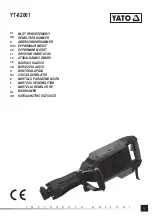
22
| English
1 609 92A 0B3 | (30.4.14)
Bosch Power Tools
– Shut the clamping lever for the plunge unit/non-plunge
base
22
.
– Adjust the required depth-of-cut; see Section “Adjusting
the Depth-of-cut”.
Separating the Routing Motor from the Plunge Unit/Non-
plunge Base (see figure C)
– Open the clamping lever for the plunge base/non-plunge
base
22
.
– Pull the routing motor to the stop and and hold it in this po-
sition.
– Press securing latch
21
and pull the routing motor com-
pletely out of the plunge base/non-plunge base. When us-
ing the non-plunge base
3
, additionally press clamping le-
ver
25
.
Inserting a Router Bit (see figure D)
It is recommended to wear protective gloves when in-
serting or replacing router bits.
Depending on the application, router bits are available in the
most different designs and qualities.
Router bits made of high speed steel (HSS)
are suitable for
the machining of soft materials, e. g. softwood and plastic.
Carbide tipped router bits (HM)
are particularly suitable for
hard and abrasive materials, e. g. hardwood and aluminium.
Original router bits from the extensive Bosch accessories pro-
gram are available at your specialist shop.
Use router bits with a shank diameter of 12 mm as far as this
is possible. Only use clean router bits that are in perfect con-
dition.
The router bit can be changed when the routing motor is
mounted in the plunge base/non-plunge base. However, it is
recommended to change the tool with the routing motor dis-
mounted.
– Remove the routing motor from the plunge base/non-
plunge base.
– Press and hold the spindle lock button
27
(
). If required,
turn the spindle by hand until the lock engages.
Actuate the spindle lock button 27 only when at a
standstill.
– Loosen the tightening nut
17
with the open-end spanner
28
(size 24 mm) by turning in antclockwise direction (
).
– Insert the router bit into the collet. The shank of the router
bit must be immersed at least 20 mm into the collet.
– Tighten the tightening nut
17
with the open-end spanner
28
(size 24 mm) by turning in clockwise direction. Release
the spindle lock button
27
.
Do not insert a router bit with a diameter larger than
50 mm when the guide bushing is not mounted.
Such
router bits do not fit through the base plate.
Do not tighten the tightening nut of the collet without a
router bit inserted.
Otherwise the collet can be damaged.
Dust/Chip Extraction
Dusts from materials such as lead-containing coatings,
some wood types, minerals and metal can be harmful to
one’s health. Touching or breathing-in the dusts can cause
allergic reactions and/or lead to respiratory infections of
the user or bystanders.
Certain dusts, such as oak or beech dust, are considered
as carcinogenic, especially in connection with wood-treat-
ment additives (chromate, wood preservative). Materials
containing asbestos may only be worked by specialists.
– As far as possible, use a dust extraction system suitable
for the material.
– Provide for good ventilation of the working place.
– It is recommended to wear a P2 filter-class respirator.
Observe the relevant regulations in your country for the mate-
rials to be worked.
Prevent dust accumulation at the workplace.
Dusts can
easily ignite.
Mounting the Extraction Adapter to the Plunge Base
(see figure E)
The extraction adapter
30
can be mounted with the hose con-
nection facing toward the front or rear. When the guide-bush-
ing adapter
50
is inserted, it may be required to mount the
guide-bushing adapter turned by 180°, so that the extraction
adapter
30
does not touch the release lever
52
. Fasten the
extraction adapter
30
with the 2 knurled screws
29
to the
base plate
13
.
To ensure optimum extraction, the extraction adapter
30
must be cleaned regularly.
Mounting the Extraction Adapter to the Non-plunge Base
(see figure F)
The extraction adapter
32
can be mounted with the hose con-
nection facing toward the front or rear. When the guide-bush-
ing adapter
50
is inserted, fasten the extraction adapter
32
with the 2 knurled screws
29
to the base plate
13
. For appli-
cations without the guide-bushing adapter
50
, firstly mount
the intermediate ring
33
to the extraction adapter
32
, as
shown in the figure.
Connecting the Dust Extraction
Insert an extraction hose (Ø 35 mm)
31
(accessory) into the
mounted extraction adapter. Connect the extraction hose
31
to a vacuum cleaner (accessory).
The machine can be plugged directly into the receptacle of a
Bosch all-purpose vacuum cleaner with remote starting con-
trol. The vacuum cleaner starts automatically when the ma-
chine is switched on.
The vacuum cleaner must be suitable for the material being
worked.
When vacuuming dry dust that is especially detrimental to
health or carcinogenic, use a special vacuum cleaner.
Operation
Starting Operation
Observe correct mains voltage! The voltage of the pow-
er source must agree with the voltage specified on the
nameplate of the machine. Power tools marked with
230 V can also be operated with 220 V.
Preselecting the Speed
The required speed can be preselected with the thumbwheel
15
(also while running).
OBJ_BUCH-1178-004.book Page 22 Wednesday, April 30, 2014 10:24 AM
















































